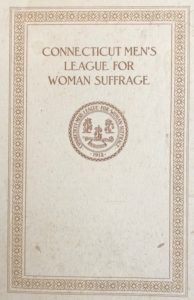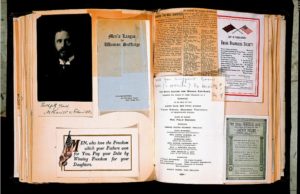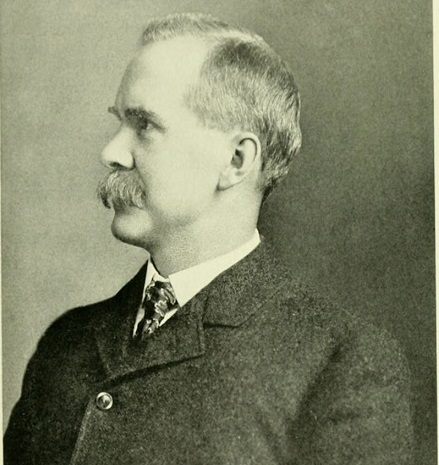By Kathleen Motes Bennewitz
Attorney General John H. Light never hesitated to share his opinion on the “woman question.” In fact, he used his visibility and influence to defend the justice of equal suffrage for women in the final push for the 19th Amendment. A court attorney by training, Light was a giant among state orators—a quality underscored by his powerful, melodious, and resonant voice, a face that bore a frank yet fearless expression, and his six-foot frame. In 1911, The Norwalk Hour described Light as having always stood for progress and that “women who believe in suffrage are fortunate in such a champion.” Yet, Light’s contributions to the Connecticut Woman’s Suffrage Association’s (CWSA) fight for political equality, like that of other notable “suffragents,” received little or no mention in official biographies.
A Farmer’s Political Rise
John Henry Light was born in 1855 in Carmel, New York. His father Belden was a farmer known for his firmness, energy, and loyalty, and his mother Ann for her great strength of character. One of eleven siblings and five half-siblings, John attended school when not working on the Somers, New York family farm. In 1880, he graduated from Chamberlain Institute and Female College, an early co-educational institution founded by Benjamin F. Chamberlain, a New York abolitionist judge.

Connecticut Men’s League for Woman Suffrage Dinner Program, Greenwich Country Club, Friday, April 17, 1914. Courtesy, Dr. Kenneth Florey.
The Lights moved to New Canaan, Connecticut by 1880 and John began studying law in Norwalk under Levi Warner, who served as a U.S. Representative. In 1883, he opened a practice in South Norwalk. The aspiring barrister quickly scaled the rank and file, first, as city attorney, and then prosecuting attorney for the Criminal Court of Common Pleas, where he eventually earned an appointment as a justice. Next, Light pursued a path as state representative for Norwalk (1899-1902), and he ascended to Speaker of the House (1901-1902). In the General Assembly, Speaker Light made his pro-suffrage stance public at a time when such advocacy could still lead to criticism. In 1910, Governor Weeks appointed Light to fill Marcus H. Holcomb’s vacated seat as Attorney General, an office to which he would be elected in 1911.
His political advancement coincided with a reinvigorated Connecticut Woman’s Suffrage Association (CWSA) led by Katharine Houghton Hepburn. The Attorney General was engaged as a prominent speaker who could articulate the case for suffrage to particular audiences and persuasively counter antis’ claims. Light spoke at town meetings— like those led by the Norwalk Equal Franchise League where his wife Ida May Lockwood Light was active—and at highly visible events, including the 1911 Litchfield County automobile tour and 1912 “Tri-County Crusade for Votes” trolley campaign. While stumping for suffrage, Light shared the dais with CWSA leaders and such renown progressive men as Max Eastman, Charles Zueblin, Charles Beard, and Lincoln Steffen. At the 1911 CWSA convention in Bridgeport, the Attorney General introduced British activist Emmeline Pankhurst, whom he lauded for her “spirit of heroism and self-sacrifice that permeated the English women to such an extent as to lead them to brave prison for the sake for their principles.”
Connecticut Men’s League for Woman Suffrage

Men’s League for Woman Suffrage ephemera, from scrapbook of Elizabeth Smith Miller and Anne Fitzhugh Miller. Library of Congress, Rare Book and Special Collections Division, Washington, D.C.
In 1912, Light helped found the Connecticut Men’s League for Woman Suffrage (CMLWS). The organization, to which Light became president, was one of twenty-six associations for men in America organized to help gain woman suffrage; the first being established in 1909 in New York City. The league began as a “council of forty” and by 1919 expanded to one hundred members.
CMLWS supporters were passionate foot soldiers for the CWSA, joining the women at parades in New York, Washington, D.C., and Hartford and at state and national suffrage conventions; they also published newsworthy media pieces and attention-getting letters to editor. At the CWSA’s request, the men exerted their influence lobbying legislators and candidates on political equality along with a special legislative session to ratify the 19th Amendment. Their relentless efforts continued until “Tennessee set Connecticut Women Free,” to quote a parade banner that CWSA president Katharine Ludington had made after clinching the 36th state’s ratification vote on August 18, 1920.
That month, CMLWS chairman, Lieutenant Governor Clifford R. Wilson, also aided the CWSA in arranging for the pealing of bells across Connecticut on the 27th to mark the 19th Amendment being signed into federal law on the day prior. Connecticut’s suffragists and suffragents collectively rejoiced again on September 14th when the General Assembly finally, and symbolically, became the 37th state to ratify the amendment.
Kathleen Motes Bennewitz serves as Westport’s town curator and helps manage the Westport Public Art Collections. She has worked for art and historical museums across the country and today is an independent American art historian and exhibition curator.









